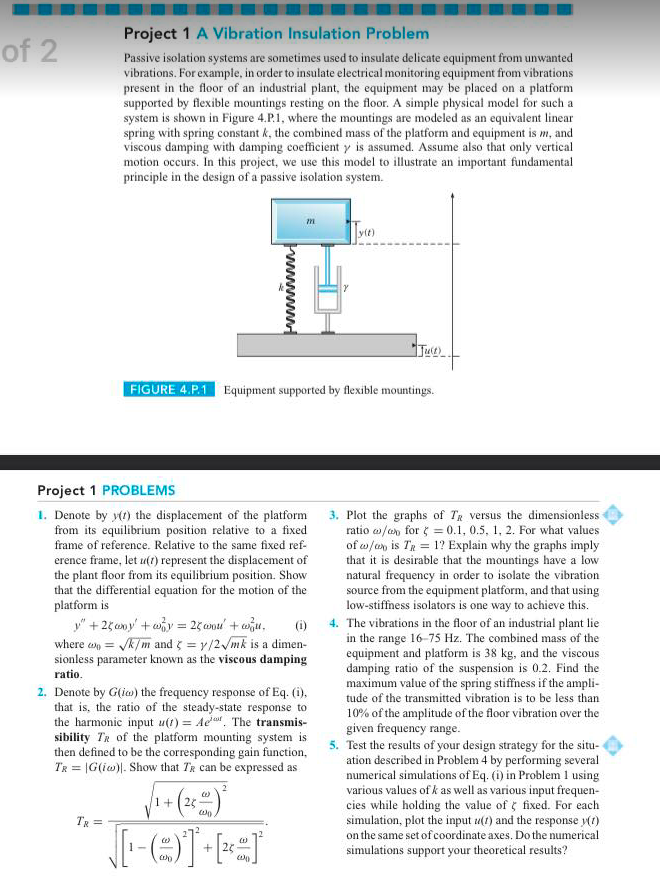passive isolation system. (t)
Principles of Heat Transfer (Activate Learning with these NEW titles from Engineering!)
8th Edition
ISBN:9781305387102
Author:Kreith, Frank; Manglik, Raj M.
Publisher:Kreith, Frank; Manglik, Raj M.
Chapter4: Numerical Analysis Of Heat Conduction
Section: Chapter Questions
Problem 4.6P
Related questions
Question
please help me in number 1

Transcribed Image Text:Project 1 A Vibration Insulation Problem
Passive isolation systems are sometimes used to insulate delicate equipment from unwanted
vibrations. For example, in order to insulate electrical monitoring equipment from vibrations
present in the floor of an industrial plant, the equipment may be placed on a platform
supported by flexible mountings resting on the floor. A simple physical model for such a
system is shown in Figure 4.P.1, where the mountings are modeled as an equivalent linear
spring with spring constant k, the combined mass of the platform and equipment is m, and
viscous damping with damping coefficient y is assumed. Assume also that only vertical
motion occurs. In this project, we use this model to illustrate an important fundamental
principle in the design of a passive isolation system.
of 2
y(t)
FIGURE 4.P.1 Equipment supported by flexible mountings.
Project 1 PROBLEMS
1. Denote by y(t) the displacement of the platform
from its equilibrium position relative to a fixed
frame of reference. Relative to the same fixed ref-
3. Plot the graphs of TR versus the dimensionless
ratio w/on for ( = 0.1, 0.5, 1, 2. For what values
of w/an is Ta = 1? Explain why the graphs imply
that it is desirable that the mountings have a low
natural frequency in order to isolate the vibration
source from the equipment platform, and that using
low-stiffness isolators is one way to achieve this.
() 4. The vibrations in the floor of an industrial plant lie
in the range 16-75 Hz. The combined mass of the
equipment and platform is 38 kg, and the viscous
damping ratio of the suspension is 0.2. Find the
maximum value of the spring stiffness if the ampli-
tude of the transmitted vibration is to be less than
erence frame, let u(t) represent the displacement of
the plant floor from its equilibrium position. Show
that the differential equation for the motion of the
platform is
y" +25omy' +why = 2 conl + wiu,
where a = k/m and = y/2/mk is a dimen-
sionless parameter known as the viscous damping
ratio.
2. Denote by G(ia) the frequency response of Eq. (i),
that is, the ratio of the steady-state response to
the harmonic input u(t) = Ae The transmis-
sibility TR of the platform mounting system is
then defined to be the corresponding gain function,
TR = |G(iw)|. Show that TR can be expressed as
10% of the amplitude of the floor vibration over the
given frequency range.
5. Test the results of your design strategy for the situ-
ation described in Problem 4 by performing several
numerical simulations of Eq. (i) in Problem 1 using
various values of k as well as various input frequen-
cies while holding the value of fixed. For each
simulation, plot the input u(t) and the response y(1)
on the same set of coordinate axes. Do the numerical
2
1+(2
TR =
+ 20
simulations support your theoretical results?
wwww
Expert Solution
This question has been solved!
Explore an expertly crafted, step-by-step solution for a thorough understanding of key concepts.
Step by step
Solved in 2 steps with 2 images

Knowledge Booster
Learn more about
Need a deep-dive on the concept behind this application? Look no further. Learn more about this topic, mechanical-engineering and related others by exploring similar questions and additional content below.Recommended textbooks for you

Principles of Heat Transfer (Activate Learning wi…
Mechanical Engineering
ISBN:
9781305387102
Author:
Kreith, Frank; Manglik, Raj M.
Publisher:
Cengage Learning

Principles of Heat Transfer (Activate Learning wi…
Mechanical Engineering
ISBN:
9781305387102
Author:
Kreith, Frank; Manglik, Raj M.
Publisher:
Cengage Learning